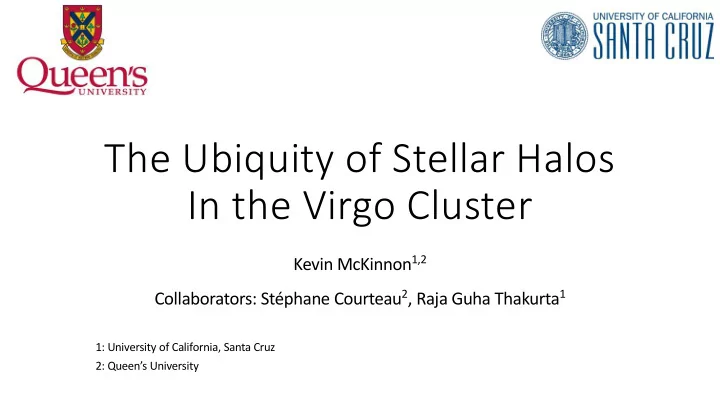

The Ubiquity of Stellar Halos In the Virgo Cluster Kevin McKinnon 1,2 Collaborators: Stéphane Courteau 2 , Raja Guha Thakurta 1 1: University of California, Santa Cruz 2: Queen’s University
Motivation • Previously hard to observe (~27 mag arcsec -2 ) 1 M31 Bulge Disk • Act as temporal window HALO of the accretion history (4%) • Helps set constraints on formation models 1 Courteau et al. 2011 (Figure 8) Kevin McKinnon - Heidelberg 2018 2
Next Generation Virgo Survey (NGVS) 1 • CFHT/ Megacam • 104 deg 2 FOV • Limiting mag g = 28.8 mag arcsec -2 Halo Domain • 415 VCC objects used • Isophotal analysis of 2D image 2 • Extraction of 1D (azimuthally averaged) surface brightness ~360 arcsec profile (20 R e ) 1 Ferrarese et al. 2012, 2 Courteau 1995 Kevin McKinnon - Heidelberg 2018 3
Profile Classification for Virgo (NGVS) Galaxies Type II Type I Type III This Work: 20% 45% 35% Previous 1 : 35% 34% 34% exponential 1 SHIVir: Roediger et al. 2012 (Table 1) Kevin McKinnon - Heidelberg 2018 5
Profile Decomposition (VCC0355) Profile Components Cumulative Light Fractions Kevin McKinnon - Heidelberg 2018 6
Halo Light Fractions (N=87) • General (expected) trend of increasing HLF with host galaxy mass (Purcell et al. 2008) • Might be seeing the mass regime where low mass galaxies begin to self-populate halo M31: Courteau et al. 2011, MW: Carollo et al. 2010, 7 Kevin McKinnon - Heidelberg 2018 VCC Structural Parameters: Ouellette et al. 2017
Recommend
More recommend